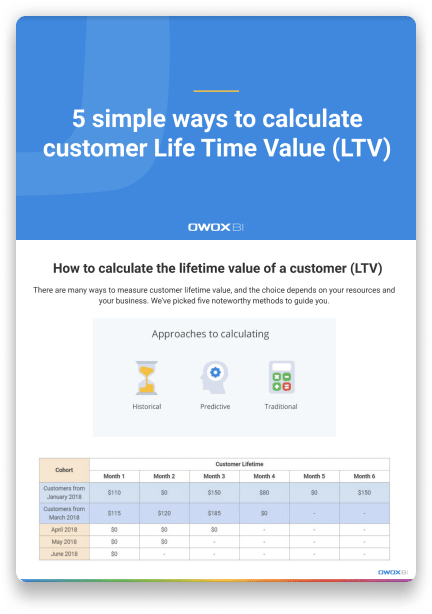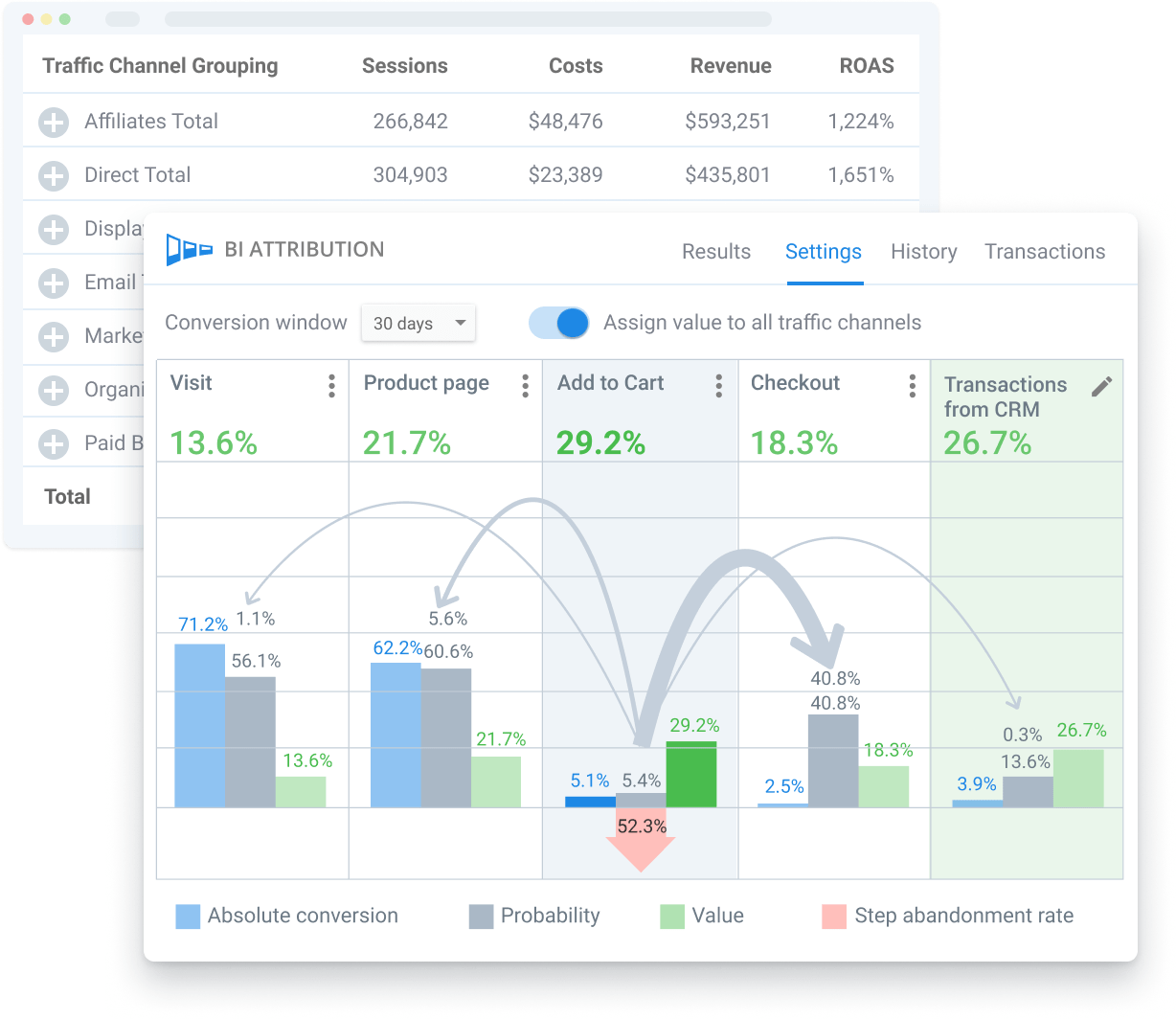Content
- Let's Understand the LTV:CAC Ratio
- What Is the Customer Lifetime Value?
- Calculating Customer LTV
- What Is the Customer Acquisition Cost?
- Calculating CAC
- How LTV:CAC Ratio Is Calculated
- What Makes a Good LTV to CAC Ratio Benchmark
- Challenges with the LTV:CAC Ratio Calculations
- Approaches to Increase LTV While Minimizing CAC
- Strategies to Improve Your Customer Lifetime Value
- Key Takeaways
Interpreting LTV:CAC Ratio: What the Numbers Reveal
Masha Efy, Creative Writer @ OWOX
When it comes to getting customers, it's typically not about getting as many as you can. The real aim is to attract those who will bring the most value to your business. But how do you know if your acquisition methods are making a profit?

That's where two essential metrics come into play: Customer Acquisition Cost (CAC) and Customer Lifetime Value (LTV). The LTV: CAC ratio is a very important metric showing the profitability of your marketing efforts, giving you insights into long-term sustainability and success.
In this article, we'll explore the importance of the LTV:CAC ratio, cover the factors that affect it and show accurate calculation methods, as well as effective strategies to improve it.
Let's Understand the LTV:CAC Ratio
The LTV to CAC ratio compares how much money a customer brings in during their lifetime (LTV) to how much it costs to acquire that customer (CAC). Therefore, it shows if gaining customers is profitable or not.
What Is the Customer Lifetime Value?
Customer Lifetime Value (LTV) is the estimated total profit that a business expects to earn from a customer over their entire relationship. It takes into account not only the initial purchase but also any additional purchases, referrals, and cross-selling.
LTV helps businesses understand the long-term value of a customer and guides decisions regarding marketing budgets and retention strategies.
Calculating Customer LTV
To understand what is a good LTV, let's take a look at calculations. The LTV calculation SaaS companies normally use is the following:
Relationship time
This method works well for SaaS businesses or marketplaces where customers consistently spend over a specified period, or if you have a subscription-based business. If your monthly revenue per customer is $100, and they spend throughout the year, the LTV calculation would be:
LTV = $100 * 12 = $1,000
If you are an eCommerce or Retail brand, it’s better to use Average Order Value as a basis for calculations:
For example, the average order value for an eCommerce business XYZ, is $100, and the average customer shops with them 7 times a year for two years. The lifetime value of this customer is calculated as follows:
LTV = $100 x 7 x 2 = $1,400
Churn rate
If you have a subscription-based model and your average customer revenue is $100 with a churn rate of 15% per month, the LTV calculation would be:
LTV = $100 / 15%
LTV = $666.67
This method focuses on customer retention and is effective for subscription models.
These are just two examples, and there are more methods available to calculate LTV. Having a higher LTV is usually a good thing because it means the customer generates more money for the business over their lifetime. However, what is considered a good LTV can vary from one business to another.
What Is the Customer Acquisition Cost?
Customer Acquisition Cost (CAC) is the total cost to get one new customer to buy for the first time. It includes different expenses associated with marketing, sales, and advertising aimed at attracting and converting potential customers.
Calculating CAC
Examples of costs included in CAC calculation are:
Let's say a business spends $10,000 on marketing campaigns, $5,000 on sales commissions, and $2,000 on lead generation tools in a given period. During that time, they acquired 100 new customers.
To calculate the CAC:
CAC = ($10,000 + $5,000 + $2,000) / 100
CAC = $17,000 / 100
CAC = $170
In this example, the Customer Acquisition Cost is $170 per customer. This means that the business spends an average of $170 to acquire a new customer.
How LTV:CAC Ratio Is Calculated
To calculate the LTV:CAC ratio, divide the customer's lifetime value (LTV) by the customer acquisition cost (CAC).
Let's say your business has an LTV of $1,000 and a CAC of $170. To calculate the LTV:CAC ratio, divide the LTV by the CAC:
$1,000/$170 = 5.88
In this example, the LTV:CAC ratio is 5.88:1 (CAC LTV ratio is 1:5.88). It means that for every dollar spent on acquisition, you can expect to generate almost six dollars in customer lifetime revenue.
What Makes a Good LTV to CAC Ratio Benchmark
After calculating the LTV:CAC ratio, the next step is to learn what is a good LTV to CAC ratio and whether the score means a favorable result.
Note: It might be different for your specific business based on the industry you are in (eg. very competitive niche), your specific cost structure (eg. selling low-margin products), or your business goals (eg. getting more clients no matter what to raise more money)
Less than 3:1
When the LTV:CAC ratio is less than 3:1, it suggests that the cost of acquiring customers is higher than the value they bring over their lifetime. This tells about an unsustainable acquisition strategy, as the business is spending more on acquiring customers than it can generate in revenue.
3:1
3:1 LTV:CAC ratio shows a healthy balance, where the lifetime value of a customer is three times higher than the acquisition cost. This means that the business is efficiently acquiring customers and generating a satisfactory ROI.
Higher than 3:1
Anything higher than 3:1 is like hitting the jackpot. It means that the value a customer brings over their lifetime is much greater than the cost to acquire them. This means a highly profitable acquisition strategy where the business is earning substantial revenue from each customer.
Uncover in-depth insights
5 simple ways to calculate customer LTV
Download nowBonus for readers

Challenges with the LTV:CAC Ratio Calculations
Achieving a profitable LTV:CAC ratio comes with its fair share of challenges. Let's explore some common problems businesses face in accurately assessing and optimizing this metric:
Accurate Data
Obtaining precise data on customer lifetime value (LTV) and customer acquisition cost (CAC) can be a bit of a headache. It involves collecting information from different sources, making sure the data is reliable and consistent. Sometimes, data might be missing or incomplete, which can throw off the calculations and make it difficult to get accurate insights for decision-making.
Complex Calculations
When calculating the ratio, you should take into account factors like customer retention rates, average purchase value, marketing expenses, and more. It is often time-consuming and requires careful analysis, making it a bit of a challenge to crunch the numbers accurately and derive meaningful insights from them.
Attribution Difficulties
A customer may interact with your website and social media ads, and receive a referral before making a purchase. Accurately attributing revenue and costs to each channel becomes a challenge as multiple touchpoints contribute to the customer's decision-making process, making it difficult to find the exact impact of each channel on the LTV/CAC ratio.
Customer Behavior Changes
A business can target a specific group of people, and suddenly, their interests and buying habits shift. This makes it difficult to accurately predict the future value of customers and adjust your acquisition strategies accordingly. What worked before may not work in the future, so businesses need to stay adaptable and keep their finger on the pulse of changing customer trends.
Scalability
If a company expands rapidly, attracting more customers and increasing acquisition costs, the lifetime value (LTV) of these new customers must grow at a similar pace or higher, ensuring that the cost remains sustainable even with the increased scale. However, achieving this balance can be tricky as the business grows, requiring careful management of resources and strategies.
Industry
The LTV/CAC ratio for a software-as-a-service (SaaS) company may differ significantly from that of a retail or ecommerce business. Therefore, finding relevant benchmarks for comparison can be a problem due to these variations, making it important to consider the specific context of your specific business.
Approaches to Increase LTV While Minimizing CAC
By implementing these approaches, businesses can increase customer engagement, reduce churn, activate more customers, and nurture long-term relationships, ultimately improving the overall lifetime value of their customer base.
How to Increase LTV | |
| ↑ Frequency | Increase the frequency of customer engagement and repeat purchases. Offer incentives, loyalty programs, or personalized recommendations to encourage customers to do business with you more often. |
↓ Churn | Focus on reducing customer churn by addressing pain points, enhancing customer satisfaction, and improving retention strategies. Provide excellent customer support service, personalized experiences, and proactive communication to build long-lasting trusted relationships. |
↑ Activation rate | Improve the onboarding process to activate and engage customers from the start. Provide clear guidance, tutorials, and personalized assistance to help customers understand the value of your products or services. |
↑ Upsells and cross-sells | Identify opportunities for upselling and cross-selling to existing customers, offering relevant products or upgrades that improve their overall experience. |
↑ Loyalty | Aim for sustained business relationships by nurturing customer loyalty. Keep regular communication, offer exclusive benefits to long-term customers, and continuously deliver value to encourage customers to stay with your business for an extended period. |
How to Reduce CAC | |
Paid vs. organic cost | Find the right balance between paid and organic customer acquisition. As paid traffic can become costly to scale, explore ways to optimize your organic channels, such as improving search engine rankings, social media engagement, and hiring affiliates. |
↑ Conversion rate | Improve your website or landing page design, streamline the user journey, provide compelling offers, and incentives to convert faster. |
↑ Personalization | Ensure you have a well-equipped team with the right skill set and resources. Invest in training and development to enhance their productivity and effectiveness in acquiring new customers. |
Optimize Acquisition channels | Analyze the cost-effectiveness of your customer acquisition channels. Identify and prioritize channels that bring in high-quality leads at a lower cost. Explore alternative channels, partnerships, or influencer collaborations that may offer more cost-effective acquisition opportunities. |
Strategies to Improve Your Customer Lifetime Value
To maximize your customer lifetime value (LTV), consider using the following strategies that add value and cultivate long-term relationships with your customers.
Customize onboarding emails
Personalize your onboarding emails to make a strong first impression. Use customer data to make the content personalized and useful, provide helpful information or resources. For example, send personalized welcome emails with recommendations based on your customer's interactions with your website.
Contact after purchase
Stay engaged with customers even after they made a purchase. Send follow-up emails, gather feedback, offer additional assistance, or provide relevant product recommendations. For instance, send post-purchase emails with related product suggestions to encourage future purchases.
Cart abandonment recovery
If you’ve managed to collect the prospect’s email - send automated emails reminding customers about their abandoned carts and offering incentives like discounts or free shipping to encourage them to complete the purchase. This can help convert hesitant customers into paying customers.
Streamline onboarding
Simplify your onboarding process to ensure a smooth customer experience. Provide clear instructions, tutorials, or videos to help customers understand and use your product or service quickly. You can offer interactive tutorials or a dedicated onboarding portal for new users.
Customer rewards initiative
Offer exclusive discounts, early access to new products, or special perks to reward and retain your customers. For example, you can have a loyalty program where customers earn points for each purchase and receive free samples or discounts after reaching a certain threshold.
Key Takeaways
Understanding the LTV:CAC ratio is important for assessing the profitability of customer acquisition efforts. By improving factors such as recurrence, reducing churn, optimizing activation rate, focusing on upsells and cross-sells, and nurturing long-term relationships, businesses can improve their customer lifetime value (LTV).
Additionally, to reduce customer acquisition cost (CAC), businesses should evaluate the balance between paid and organic customer acquisition, aim for higher conversion rates, assess their marketing team's efficiency, and analyze the cost-effectiveness of acquisition channels.
By implementing these strategies, you can drive sustainable growth, increase profitability, and achieve long-term success.
FAQ
-
What is a good customer lifetime value (CAC) ratio?
A good customer lifetime value (CAC) ratio depends on the industry and business model. Generally, a ratio greater than 1 indicates profitability, but what makes a good ratio can vary. It is important to compare the ratio to industry benchmarks and ensure that the LTV outweighs the CAC to drive sustainable growth and profitability. -
Why is LTV CAC important?
It helps businesses understand the profitability of their customer acquisition efforts, provides insights into ROI, and guides decision-making for resource allocation and growth strategies. -
How do you calculate CAC vs LTV ratio?
The CAC vs LTV ratio is calculated by dividing the customer lifetime value (LTV) by the customer acquisition cost (CAC).











